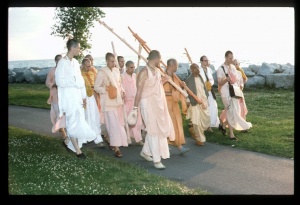CC Madhya 10.166 (1975)

A.C. Bhaktivedanta Swami Prabhupada
TEXT 166
- 'brahmānanda' nāma tumi-gaura-brahma 'cala'
- śyama-varṇa jagannātha vasiyāchena 'acala'
SYNONYMS
brahmānanda—Brahmānanda; nāma tumi—your name; gaura-brahma—the Brahman of the name Gaura; cala—both of them are moving; śyāma-varṇa—of blackish hue; jagannātha—Lord Jagannātha; vasiyāchena—is sitting; acala—without movement.
TRANSLATION
"Both Brahmānanda and Gaurahari are moving, whereas the blackish Lord Jagannātha is sitting tight and immobile."
PURPORT
Brahmānanda Bhāratī wanted to prove that there is no difference between the Supreme Lord and the jīva, while Caitanya Mahāprabhu wanted to prove that He and Brahmānanda Bhāratī were jīvas and that although the jīvas are Brahman, they are many, but the Supreme Lord, the Supreme Brahman, is one. On the other hand, Brahmānanda Bhāratī also wanted to prove that Jagannātha and Śrī Caitanya Mahāprabhu are one, the Supreme Personality of Godhead, but that to fulfill His mission Śrī Caitanya Mahāprabhu appeared to be moving whereas Lord Jagannātha appeared to be inert. Thus this jolly argument was going on. Finally, Brahmānanda Bhāratī referred the whole matter to Sārvabhauma Bhaṭṭācārya for a final decision.